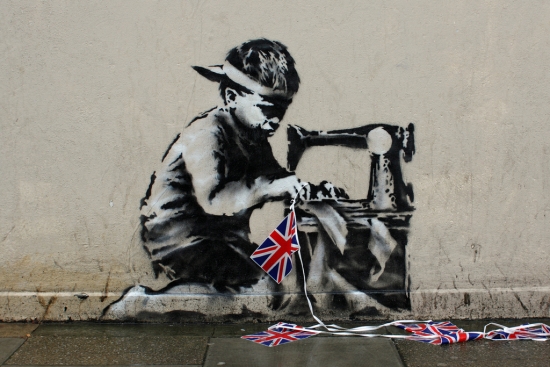The landlords at the centre of an international wrangle over a mural by celebrated street artist Banksy have finally broken their silence over the issue. Robert Davies and Les Gilbert, directors of property firm Wood Green Investments, claim they are ‘mortified’ by the attention the case has brought and wish the work had never appeared on the wall in the first place.

The mural, known as Slave Labour, depicts a young boy kneeling over a sewing machine stitching Union Jack bunting. It appeared on the wall of a Poundland store in Wood Green prior to last summer’s Diamond Jubilee celebrations and is widely interpreted as a critique of overseas sweatshops manufacturing cheap royal memorabilia.
It disappeared over the weekend of 16-17 February before mysteriously being offered for auction in Miami where it was expected to fetch around £450,000. This provoked a public outcry leading to its last minute withdrawal from the auction amid calls for it to be returned home.
The FBI subsequently asked Scotland Yard to investigate the matter and it is reported that the Met’s arts and antiques unit have begun preliminary inquiries in an attempt to discover the circumstances surrounding the murals’ removal and subsequent emergence nearly 4,500 miles away. However, they appear reluctant to treat it as a criminal matter.
Speculation in the media has centred on Davies and Gilbert, who own the freehold on the Wood Green property, and their silence has only raised suspicions that they were party to the disappearance of the mural. Now they have spoken out, telling the Evening Standard it has caused nothing but trouble and criticising the council for not doing enough to protect the artwork.
“I cannot believe it’s over graffiti on a wall that has caused all this. We had a case with one of our buildings where we had graffiti and the council told us they would fine us £1,000 if we didn’t remove it.
“The council has done nothing to protect it. They’ve not helped us in any way. They’ve just caused us more problems and more problems,” Mr Davies said.
A friend explained that, when the spray painted stencil appeared on the wall of the property, the landlords were menaced by local gangs demanding protection money.
“The last thing they wanted was this,” he said. “They wish it had never arrived.
“In future, when Banksy does something like this again, the council should immediately record it as a piece of art and put a vented, bullet-proof system around it to protect it forever. A plaque could go on it,” he added.
While calling for ‘bullet-proof’ protection may be overstating the case somewhat, these comments touch on a contentious issue. Who does art in the public realm belong to, who is responsible for its preservation and, ultimately, who is entitled to profit from it?
The comments from Wood Green Investments do little to shed light on who chiselled the 4ft by 5ft slab of concrete from the wall of the property or on whose behalf the auctioneers were offering the lot. For their part, Fine Art Auctions insist they have not acted improperly but have so far offered no explanation for the item’s sudden withdrawal.
The mystery is compounded by the fact that, despite a number of gallery shows, Banksy chooses to remain shrouded in myth, much of it of his own making. His identity is uncertain, but he has previously been named as Robin Banks or Robin Cunningham and he is widely acknowledged to originate from Bristol.
In the past he has cited the fear of prosecution as the reason for concealing his identity but, as this incident demonstrates, it is unlikely that a landlord or local authority would choose to take any action whatsoever against a figure whose work now commands six figure sums.
Whatever the truth of the matter, Clare Kober, the leader of Haringey Council, has pledged that the local authority will now seek to return the mural to ‘the community where it belongs.’
Previous Post
Shops in Bristol City Centre Buck Poor UK Retail Trend
No related posts found for this post.